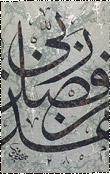| |

| |
 |
| Haza mim |
|
|

| |
1
OF 3 |
 |
 Following
the conquest of Istanbul, the Ottoman state rose to heights of achievement
not only in the military and political arena, but in the spheres
of culture and art. Seyh Hamdullah (833-926/1429-1520), who like
his predecessor Yâkût (?-698/1298), came from the northern Turkish
town of Amasya, began by following and perfecting the style of Yâkût.
However, encouraged by his patron and student Sultan Bayezid II
(lived: 1450-1512), he went on to subject the works of Yâkût to
aesthetic scrutiny and incorporate his own artistic values, developing
a new and original style around 1485. Known as the "Seyh Manner",
this brought the Yâkût period of Ottoman Turkish calligraphy to
a close. Ahmed Karahisâri (?-963/1556) revived the Yâkût style with
unsurpassed brilliance during the age of Sultan Süleyman the Magnificent,
but upon his death the style fell into oblivion again. The Karahisâri
school was inarguably superior in writing celî sülüs to the Seyh
Hamdullah manner, although the latter prevailed. Following
the conquest of Istanbul, the Ottoman state rose to heights of achievement
not only in the military and political arena, but in the spheres
of culture and art. Seyh Hamdullah (833-926/1429-1520), who like
his predecessor Yâkût (?-698/1298), came from the northern Turkish
town of Amasya, began by following and perfecting the style of Yâkût.
However, encouraged by his patron and student Sultan Bayezid II
(lived: 1450-1512), he went on to subject the works of Yâkût to
aesthetic scrutiny and incorporate his own artistic values, developing
a new and original style around 1485. Known as the "Seyh Manner",
this brought the Yâkût period of Ottoman Turkish calligraphy to
a close. Ahmed Karahisâri (?-963/1556) revived the Yâkût style with
unsurpassed brilliance during the age of Sultan Süleyman the Magnificent,
but upon his death the style fell into oblivion again. The Karahisâri
school was inarguably superior in writing celî sülüs to the Seyh
Hamdullah manner, although the latter prevailed.
Of the six scripts inherited from Yâkût, sülüs and nesih, which
were especially compatible with Turkish taste, spread rapidly during
the Seyh Hamdullah era, and nesih became the only script used to
copy the Koran. Due to the paucity of rounded characters and the
broad shape of muhakkak and reyhânî, these hands were gradually
abandoned, until eventually they were used solely as exercises by
calligraphers to improve their dexterity. As a result they occur
in later years only in murakkaa (writing albums) in which calligraphers
practised copying inscriptions. The only exception is the tradition
of writing the Besmele (the formula bismillahirrahmanirrahim meaning
"in the name of God, the Compassionate, the Merciful), which
has continued to be written in muhakkak to the present day. Rika'
evolved into a more appealing form which under the name hatt-i icâze
was used notably by calligraphers to write their signatures and
the diplomas given to calligraphy students. Tevkî', however, fell
largely into disuse
. Seyh
Hamdullah's successors devoted their efforts to imitating their
master, and took this to such an extreme that the greatest words
of praise a celebrated calligrapher could expect was, "He writes
like the Seyh", or to be called, "A second Seyh Hamdullah".
This situation continued for over 150 years. At last, in the second
half of the 17th century, the light of a new master illuminated
the horizon of art in Istanbul. This was Hâfiz Osman (1052-1110/1642-1698),
who subjected the style of Seyh Hamdullah, whose writing was based
on selected aspects of Yâkût's work, to a process of elimination,
and proceeded to evolve an original manner of his own, characterised
by relatively greater purity. The "Seyh style" now made
way for that of Hâfiz Osman. Seyh
Hamdullah's successors devoted their efforts to imitating their
master, and took this to such an extreme that the greatest words
of praise a celebrated calligrapher could expect was, "He writes
like the Seyh", or to be called, "A second Seyh Hamdullah".
This situation continued for over 150 years. At last, in the second
half of the 17th century, the light of a new master illuminated
the horizon of art in Istanbul. This was Hâfiz Osman (1052-1110/1642-1698),
who subjected the style of Seyh Hamdullah, whose writing was based
on selected aspects of Yâkût's work, to a process of elimination,
and proceeded to evolve an original manner of his own, characterised
by relatively greater purity. The "Seyh style" now made
way for that of Hâfiz Osman.
| |
1
OF 3 |
 |
|
|


